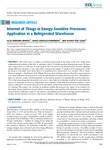Internet of Things in Energy-Sensitive Processes: Application in a Refrigerated Warehouse

Use this link to cite
http://hdl.handle.net/2183/40290
Except where otherwise noted, this item's license is described as Attribution-NonCommercial-NoDerivatives 4.0
https://creativecommons.org/licenses/by-nc-nd/4.0/
Collections
Metadata
Show full item recordTitle
Internet of Things in Energy-Sensitive Processes: Application in a Refrigerated WarehouseDate
2024-05-29Citation
J. B. Montes, S. Z. Fernández, y V. D. Casas, «Internet of Things in Energy-Sensitive Processes: Application in a Refrigerated Warehouse», IEEE Access, vol. 12, pp. 76257-76276, 2024, doi: 10.1109/ACCESS.2024.3406992.
Abstract
[Abstract]: This article aims to address an existing research gap in the study of the most widely used mathematical procedures in the field of automatic control of energy-sensitive industrial processes. In these types of processes, as is the case of cold storage in the food sector or the pharmaceutical industry, applying energy efficiency measures is very risky. This is because the margin of variation in the temperature of the processes is very small, since the product to be manufactured or preserved is very sensitive. This is where the developments of the Internet of the Things showcase their usefulness because they allow measurements to be taken with great accuracy and to verify the effectiveness of energy efficiency proposals. Nevertheless, there are very few studies and developments on automation measures in energetically sensitive industries. This is the research gap that the present work aims to shed light on, proposing a method for optimizing the process of automatic revision in a refrigerated food warehouse. Said method prominently employs control charts, as they allow for a relatively easy set up and require minimal intervention but can be revised manually if so desired. The analysis also includes an auxiliary variable that measures the impact of the variations in the system. Improvements are also provided to the procedures and variables, with which the most commonly used methods of efficiency control in the industry can maintain good results in energy-sensitive industries.
Finally, the best selection of charts for the chosen variables is then discussed and justified.
Keywords
Control charts
Energy efficiency
Industrial Internet of things
Internet of things (IoT)
IoT applications
Temperature control
Warehousing
Energy efficiency
Industrial Internet of things
Internet of things (IoT)
IoT applications
Temperature control
Warehousing
Editor version
Rights
Attribution-NonCommercial-NoDerivatives 4.0
https://creativecommons.org/licenses/by-nc-nd/4.0/
ISSN
2169-3536






